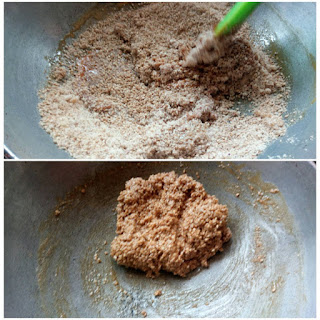In India, for makar sankranti festival, foods are made with sesame seeds and
jaggery. Tilachi vadi or Tilgul is one of the popular sweets distributed among
friends at such time. Til [pronounced as
Teel] are the sesame seeds and vadi is a type of sweet made out of these seeds,
along with jaggery [gul]. Some communities in India, including mine, make these
sweets today, that is, on Makar Sankranti. As the consumption of sesame seeds
generates heat in the body. It is extremely ‘hot’ sweet. It is therefore, made
on this day, which lies in January….. one of the winter months in India. Makar
Sankranti usually falls on 14 january but when it is a leap year, it is on the
15 th January, like it is this year. In Mahrashtra, we exchange sweets made out
of tilgul and wish each other “ Tilgul Ghya Ani Goad Goad Bola”. It translates
in english saying, “Take Tilgul[sweets] and speak sweetly”. We also make other
sweets on the day, including the delicious gul-poli.Now let’s dug in to the
recipe of Tilgul Vadis.
INGREDIENTS:
¾ Cup Til [sesame seeds]
¾ Cup Jaggery [gul]
¼ Cup roasted Peanut Powder
1 teaspoon Ghee [+ more for greasing plate/ kitchen counter]
1 teaspoon Milk
¼ teaspoon Cardamom Powder
½ tablespoon Grated Coconut, dry
METHOD:
STEP 1 – Roast til on medium flame till light golden in colour.
Transfer in a plate and let them cool to room temperature.
STEP 2 – Grease kitchen counter or a plate with ghee and sprinkle some roasted sesame seeds over it. Keep this aside.
STEP 3 – Now take half of the sesame seeds in a mixer pot and blend it to a coarse powder. Keep half of them aside.
STEP 4 – Take a thick bottomed pan, heat it and add jaggery in to it. Melt it, when it starts to boil and frothy, switch off the flame. [see notes]
STEP 5 – Add sesame seeds powder, remaining half of the sesame seeds, peanuts powder, ghee, milk and cardamom powder in it.
STEP 6 – Let it mix well to form a dough like ball.
STEP 7 – Transfer it to greased surface and spread it evenly with hands. [see notes] Here you have to work fast because once the mixture get cooled, you are not be able to spread it well.
STEP 8 – Now sprinkle desiccated coconut over it and again roll in once with a rolling pin so that coconut will stick to the mixture.
STEP 9 – Let it cool completely After that cut it in to desired shape square / diamond and til vadi is ready to serve.
NOTES: *When you are melting jaggery, first keep the flame high. As it starts melting, turn it to low.
*When jaggery get melted and starts boiling, you can see bubbles on the surface with frothy texture.
*You can use greased rolling pin for spreading the mixture evenly.
INGREDIENTS:
¾ Cup Til [sesame seeds]
¾ Cup Jaggery [gul]
¼ Cup roasted Peanut Powder
1 teaspoon Ghee [+ more for greasing plate/ kitchen counter]
1 teaspoon Milk
¼ teaspoon Cardamom Powder
½ tablespoon Grated Coconut, dry
METHOD:
STEP 1 – Roast til on medium flame till light golden in colour.
Transfer in a plate and let them cool to room temperature.
STEP 2 – Grease kitchen counter or a plate with ghee and sprinkle some roasted sesame seeds over it. Keep this aside.
STEP 3 – Now take half of the sesame seeds in a mixer pot and blend it to a coarse powder. Keep half of them aside.
STEP 4 – Take a thick bottomed pan, heat it and add jaggery in to it. Melt it, when it starts to boil and frothy, switch off the flame. [see notes]
STEP 5 – Add sesame seeds powder, remaining half of the sesame seeds, peanuts powder, ghee, milk and cardamom powder in it.
STEP 6 – Let it mix well to form a dough like ball.
STEP 7 – Transfer it to greased surface and spread it evenly with hands. [see notes] Here you have to work fast because once the mixture get cooled, you are not be able to spread it well.
STEP 8 – Now sprinkle desiccated coconut over it and again roll in once with a rolling pin so that coconut will stick to the mixture.
STEP 9 – Let it cool completely After that cut it in to desired shape square / diamond and til vadi is ready to serve.
NOTES: *When you are melting jaggery, first keep the flame high. As it starts melting, turn it to low.
*When jaggery get melted and starts boiling, you can see bubbles on the surface with frothy texture.
*You can use greased rolling pin for spreading the mixture evenly.






















































